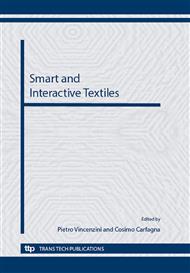p.22
p.30
p.39
p.47
p.53
p.59
p.65
p.71
p.77
Integration of Small Diameter Wire Form SMA for the Creation of Dynamic Shape Memory Textiles
Abstract:
The integration of Nitinol wire directly into flexible textile structures has seen limited successful research outcomes. This has mainly been due to issues with shape training and the accurate positioning of the Nitinol components. A new approach is investigated here, which utilises small diameter (0.15mm - 0.10mm) Nitinol components and the manipulation of the woven structure. This combined approach has the potential to improve the dynamic control of the resulting textiles, giving the textile designer further latitude to adapt a combination of functional and visual properties, as well as expanding application possibilities. This investigation focuses on the development of composite samples that integrate Nitinol directly into woven cotton, Kevlar, polyester and polypropylene textiles, demonstrating the potential for medical and healthcare applications. The prototype composite textiles developed, investigate a range of controlled surface manipulations as well as larger scale shape changes, including the creation of arced forms, pleating, expansion and compression. With supporting data, the evaluation of these samples explores the potential of integrating small diameter Nitinol wires into woven structures and the resultant levels of shape transfer, control and cyclic speed achievable.
Info:
Periodical:
Pages:
53-58
Citation:
Online since:
September 2012
Authors:
Keywords:
Price:
Сopyright:
© 2013 Trans Tech Publications Ltd. All Rights Reserved
Share:
Citation:


